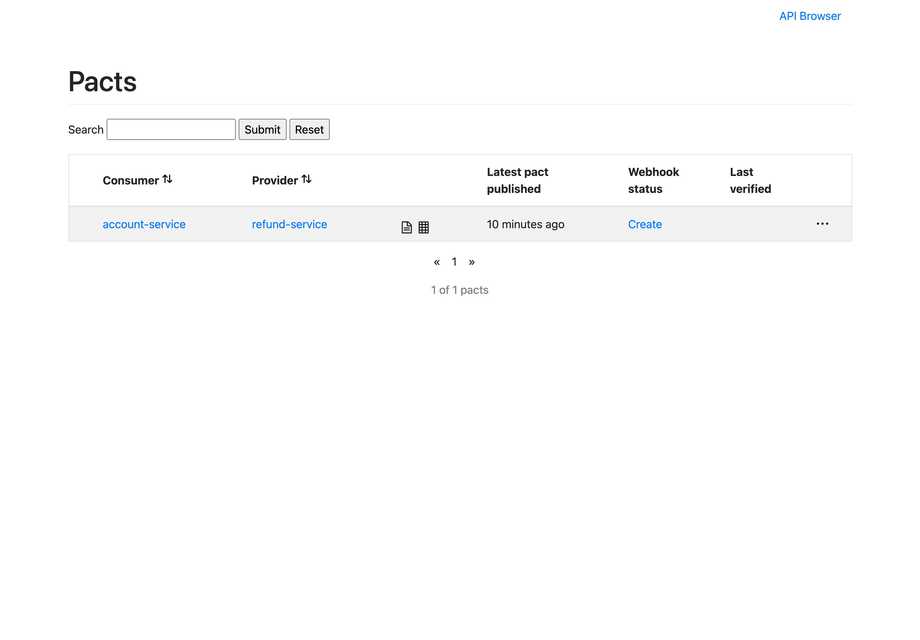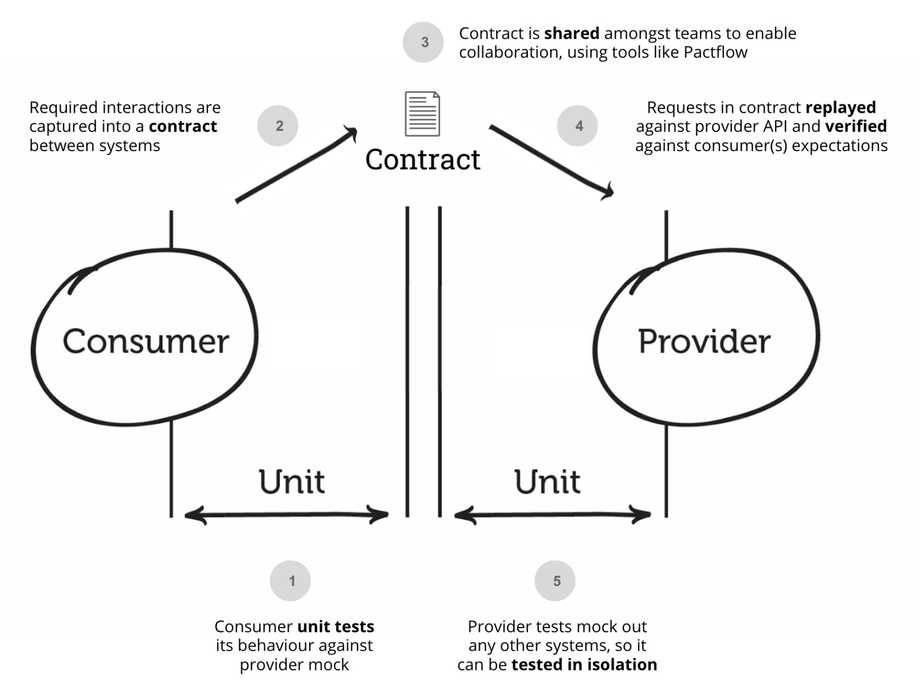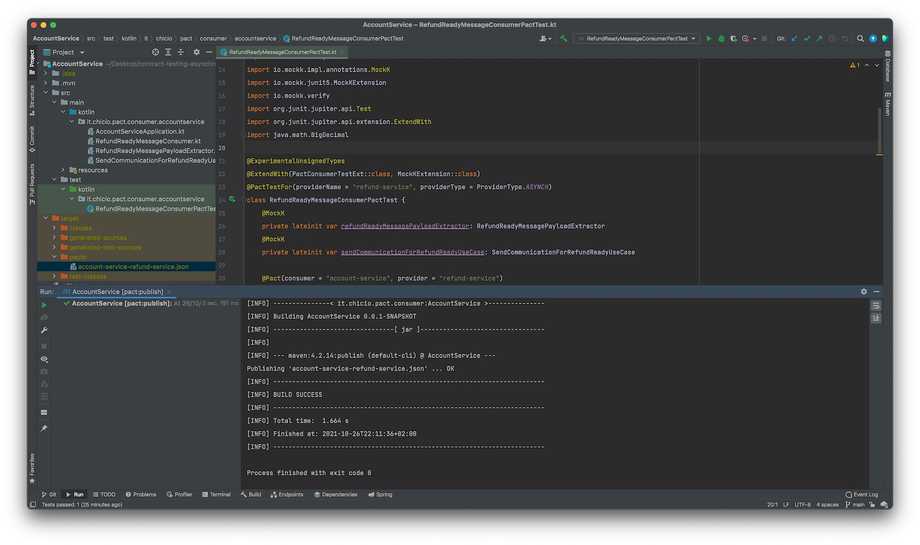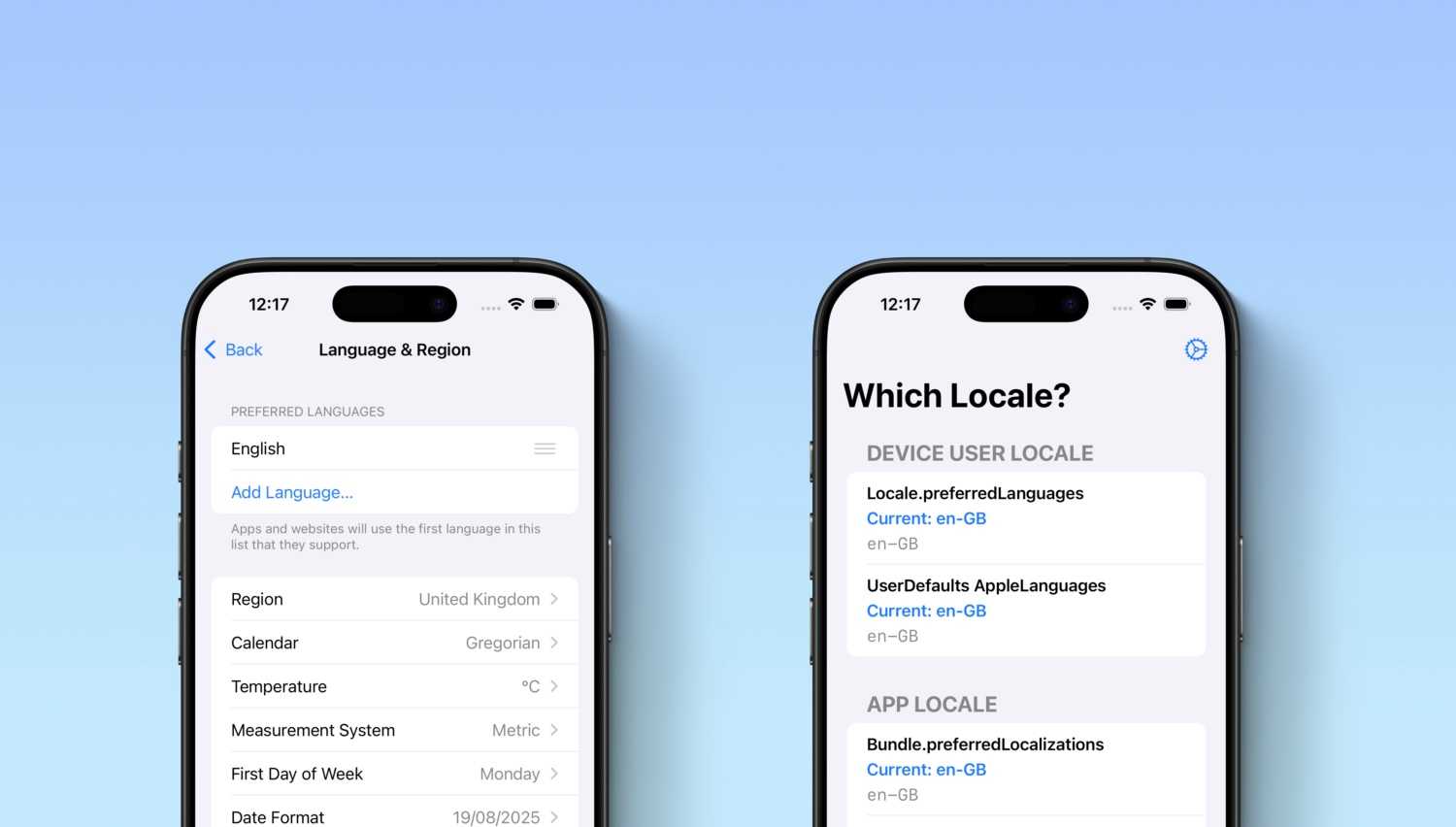In the last weeks I worked with my colleague Felice Giovinazzo on a new feature for the refund process (as may already know from some of my previous posts in the last 2 years I worked mainly on backend applications). In this new feature we have a messaging-based communication between microservices. The messaging system used is RabbitMQ. In lastminute.com group we are already using Pact to implement contract testing for the classic RESTful interaction between microservices. What is contract testing? Let’s have a look at the definition from the Pact website.
Contract tests assert that inter-application messages conform to a shared understanding that is documented in a contract. Without contract testing, the only way to ensure that applications will work correctly together is by using expensive and brittle integration tests.
Do you set your house on fire to test your smoke alarm? No, you test the contract it holds with your ears by using the testing button. Pact provides that testing button for your code, allowing you to safely confirm that your applications will work together without having to deploy the world first.
So contract testing is a way to ensure that two application communicate correctly by adhering to a contract that describe the API or the message exchanged between them. Cool, isn’t it? 😏
In this post I will show you how me and Felice tested a messaging interaction between two microservices using Pact with the help of Stefano Varesi, a senior software engineer that works in the lastminute.com team that introduced Pact in the company. How does it work? Pact is a consumer driven contract testing: it is responsibility of the consumer to generate the contract that will be used by the provider to verify its correctness. As you can see from the image above, there are three key actors in pact test:
- the consumer of an API
- the provider of an API
- a pact broker, an application used to share contracts and verification results between consumers and providers.
The workflow to write a consumer driven contract test is the following one:
- write the contract test on the consumer
- publish the contract obtained by executing the contract test on the consumer side
- write the provider test using the contract published before as a proof of correctness of your API
The same flow is applied in case of a message/event driven architecture: start with the test of the message consumer, publish the contract and then write the message producer test. Now that everything is clear we can start to write our first Pact test for message exchange between two microservices. Let’s go!!! 🚀
Setup
Our example application is composed by two microservices:
RefundService, a spring boot web application that manages everything related to the refund of an order of a customer. In our example this application will be the producer of a refund ready message.AccountService, a spring boot web application that manages everything related to the customer account. In our example this application will be the consumer of a refund ready message that came from theRefundServiceapplication.
Let’s see the dependencies need by these applications. Both of them will depend on these libraries/languages:
- spring boot, kotlin, arrow (kotlin functional programming library) production code
- spring boot starter test, kotest and mockk for the testing part
For writing our Pact test:
RefundServicewill have the dependency needed in order to write the pact provider testau.com. dius.pact.provider.junit5AccountServicewill have the dependency needed in order to write the pact consumer testau.com.dius.pact. consumer.junit5
In the AccountService application, so on the consumer side, we need also to set up the maven
plugin au.com.dius. pact.provider.maven that will let us publish our contracts on the pact broker. Below you can find
the maven pom.xml of the applications.
<?xml version="1.0" encoding="UTF-8"?>
<project xmlns="http://maven.apache.org/POM/4.0.0" xmlns:xsi="http://www.w3.org/2001/XMLSchema-instance"
xsi:schemaLocation="http://maven.apache.org/POM/4.0.0 https://maven.apache.org/xsd/maven-4.0.0.xsd">
<modelVersion>4.0.0</modelVersion>
<parent>
<groupId>org.springframework.boot</groupId>
<artifactId>spring-boot-starter-parent</artifactId>
<version>2.5.6</version>
<relativePath/> <!-- lookup parent from repository -->
</parent>
<groupId>it.chicio.pact.provider</groupId>
<artifactId>RefundService</artifactId>
<version>0.0.1-SNAPSHOT</version>
<name>RefundService</name>
<description>Message provider example</description>
<properties>
<java.version>11</java.version>
<kotlin.version>1.5.31</kotlin.version>
<arrow.version>1.0.0</arrow.version>
<pact.version>4.2.14</pact.version>
</properties>
<dependencies>
<dependency>
<groupId>org.springframework.boot</groupId>
<artifactId>spring-boot-starter</artifactId>
</dependency>
<dependency>
<groupId>org.jetbrains.kotlin</groupId>
<artifactId>kotlin-reflect</artifactId>
</dependency>
<dependency>
<groupId>org.jetbrains.kotlin</groupId>
<artifactId>kotlin-stdlib-jdk8</artifactId>
</dependency>
<dependency>
<groupId>com.fasterxml.jackson.module</groupId>
<artifactId>jackson-module-kotlin</artifactId>
<version>2.13.0</version>
</dependency>
<!-- arrow -->
<dependency>
<groupId>io.arrow-kt</groupId>
<artifactId>arrow-core</artifactId>
<version>${arrow.version}</version>
</dependency>
<!-- base test dependencies -->
<dependency>
<groupId>org.springframework.boot</groupId>
<artifactId>spring-boot-starter-test</artifactId>
<scope>test</scope>
</dependency>
<dependency>
<groupId>io.kotest</groupId>
<artifactId>kotest-runner-junit5-jvm</artifactId>
<version>4.6.3</version>
<scope>test</scope>
</dependency>
<dependency>
<groupId>io.mockk</groupId>
<artifactId>mockk</artifactId>
<version>1.12.0</version>
<scope>test</scope>
</dependency>
<!-- pact provider dependency -->
<dependency>
<groupId>au.com.dius.pact.provider</groupId>
<artifactId>junit5</artifactId>
<version>4.2.14</version>
<scope>test</scope>
</dependency>
</dependencies>
<build>
<sourceDirectory>${project.basedir}/src/main/kotlin</sourceDirectory>
<testSourceDirectory>${project.basedir}/src/test/kotlin</testSourceDirectory>
<plugins>
<plugin>
<groupId>org.springframework.boot</groupId>
<artifactId>spring-boot-maven-plugin</artifactId>
</plugin>
<plugin>
<groupId>org.jetbrains.kotlin</groupId>
<artifactId>kotlin-maven-plugin</artifactId>
<configuration>
<args>
<arg>-Xjsr305=strict</arg>
</args>
<compilerPlugins>
<plugin>spring</plugin>
</compilerPlugins>
</configuration>
<dependencies>
<dependency>
<groupId>org.jetbrains.kotlin</groupId>
<artifactId>kotlin-maven-allopen</artifactId>
<version>${kotlin.version}</version>
</dependency>
</dependencies>
</plugin>
</plugins>
</build>
</project><?xml version="1.0" encoding="UTF-8"?>
<project xmlns="http://maven.apache.org/POM/4.0.0" xmlns:xsi="http://www.w3.org/2001/XMLSchema-instance"
xsi:schemaLocation="http://maven.apache.org/POM/4.0.0 https://maven.apache.org/xsd/maven-4.0.0.xsd">
<modelVersion>4.0.0</modelVersion>
<parent>
<groupId>org.springframework.boot</groupId>
<artifactId>spring-boot-starter-parent</artifactId>
<version>2.5.6</version>
<relativePath/>
</parent>
<groupId>it.chicio.pact.consumer</groupId>
<artifactId>AccountService</artifactId>
<version>0.0.1-SNAPSHOT</version>
<name>AccountService</name>
<description>Message consumer example</description>
<properties>
<java.version>11</java.version>
<kotlin.version>1.5.31</kotlin.version>
<arrow.version>1.0.0</arrow.version>
<pact.version>4.2.14</pact.version>
</properties>
<dependencies>
<dependency>
<groupId>org.springframework.boot</groupId>
<artifactId>spring-boot-starter</artifactId>
</dependency>
<dependency>
<groupId>org.jetbrains.kotlin</groupId>
<artifactId>kotlin-reflect</artifactId>
</dependency>
<dependency>
<groupId>org.jetbrains.kotlin</groupId>
<artifactId>kotlin-stdlib-jdk8</artifactId>
</dependency>
<!-- arrow -->
<dependency>
<groupId>io.arrow-kt</groupId>
<artifactId>arrow-core</artifactId>
<version>${arrow.version}</version>
</dependency>
<!-- base test dependencies -->
<dependency>
<groupId>org.springframework.boot</groupId>
<artifactId>spring-boot-starter-test</artifactId>
<scope>test</scope>
</dependency>
<dependency>
<groupId>io.kotest</groupId>
<artifactId>kotest-runner-junit5-jvm</artifactId>
<version>4.6.3</version>
<scope>test</scope>
</dependency>
<dependency>
<groupId>io.mockk</groupId>
<artifactId>mockk</artifactId>
<version>1.12.0</version>
<scope>test</scope>
</dependency>
<!-- pact consumer dependency -->
<dependency>
<groupId>au.com.dius.pact.consumer</groupId>
<artifactId>junit5</artifactId>
<version>${pact.version}</version>
<scope>test</scope>
</dependency>
</dependencies>
<build>
<sourceDirectory>${project.basedir}/src/main/kotlin</sourceDirectory>
<testSourceDirectory>${project.basedir}/src/test/kotlin</testSourceDirectory>
<plugins>
<plugin>
<groupId>org.springframework.boot</groupId>
<artifactId>spring-boot-maven-plugin</artifactId>
</plugin>
<plugin>
<groupId>org.jetbrains.kotlin</groupId>
<artifactId>kotlin-maven-plugin</artifactId>
<configuration>
<args>
<arg>-Xjsr305=strict</arg>
</args>
<compilerPlugins>
<plugin>spring</plugin>
</compilerPlugins>
</configuration>
<dependencies>
<dependency>
<groupId>org.jetbrains.kotlin</groupId>
<artifactId>kotlin-maven-allopen</artifactId>
<version>${kotlin.version}</version>
</dependency>
</dependencies>
</plugin>
<!-- pact publish plugin -->
<plugin>
<groupId>au.com.dius.pact.provider</groupId>
<artifactId>maven</artifactId>
<version>${pact.version}</version>
<configuration>
<pactBrokerUrl>http://localhost</pactBrokerUrl>
</configuration>
</plugin>
</plugins>
</build>
</project>Now we need to set up our pact broker. For our example we can create a local instance using the docker compose file contained in the pact broker official repo. Obviously for a real production case you need to host your broker somewhere in your environment. The services initialized in the docker compose file include:
- the pact broker PostgreSQL database instance
- the pact broker web app
- a nginx instance used as reverse proxy (in fact if you want to use/keep it in the docker compose file you have to download from the pact broker repository also the self-signed certificate used for TLS).
Below you can find the entire docker compose file.
version: "3"
services:
postgres:
image: postgres
healthcheck:
test: psql postgres --command "select 1" -U postgres
volumes:
- postgres-volume:/var/lib/postgresql/data
environment:
POSTGRES_USER: postgres
POSTGRES_PASSWORD: password
POSTGRES_DB: postgres
pact-broker:
image: pactfoundation/pact-broker:2.89.0.0
ports:
- "9292:9292"
depends_on:
- postgres
environment:
PACT_BROKER_PORT: '9292'
PACT_BROKER_DATABASE_URL: "postgres://postgres:password@postgres/postgres"
PACT_BROKER_LOG_LEVEL: INFO
PACT_BROKER_SQL_LOG_LEVEL: DEBUG
# PACT_BROKER_DATABASE_CONNECT_MAX_RETRIES is only needed for docker-compose
# because the database takes longer to start up than the puma process
# Should not be needed in production.
PACT_BROKER_DATABASE_CONNECT_MAX_RETRIES: "5"
# The list of allowed base URLs (not setting this makes the app vulnerable to cache poisoning)
# This allows the app to be addressed from the host from within another docker container correctly
PACT_BROKER_BASE_URL: 'https://localhost http://localhost http://localhost:9292 http://pact-broker:9292'
# Nginx is not necessary, but demonstrates how
# one might use a reverse proxy in front of the broker,
# and includes the use of a self-signed TLS certificate
nginx:
image: nginx:alpine
depends_on:
- pact-broker
volumes:
- ./ssl/nginx.conf:/etc/nginx/conf.d/default.conf:ro
- ./ssl:/etc/nginx/ssl
ports:
- "443:443"
- "80:80"
volumes:
postgres-volume:We can build all the containers defined in it with the docker compose commands below.
docker-compose build
docker-compose upAfter running the commands above we will have a pact broker local instance. We can access it in the browser (as localhost) and below you can see the homepage with an example contract listed. We are now ready to write our test.
Implementation
As we said in the introduction, we are using the consumer driven contract test approch. This means that for our
example we will start from AccountService, the message consumer. In this microservice we have a
RefundReadyMessageConsumer, that consume the message received from RefundService. Inside this class we have two
collaborator:
RefundReadyMessagePayloadExtractor, a collaborator that extract the payload from the message receivedSendCommunicationForRefundReadyUseCase, a use case that uses the payload information to send a communication to the user
The payload of the message, represented by the RefundReadyMessage data class is very simple. It contains the id
that identify the refund due to the user and the relative amount (represented as a combination of value and currency).
data class Money(
val value: BigDecimal,
val currency: String
)
data class RefundReadyMessage(
val refundId: Long,
val amount: Money
)
interface RefundReadyMessagePayloadExtractor {
fun extract(message: String): Either<CantExtractMessage, RefundReadyMessage>
}
object RefundCommunicationSent
interface SendCommunicationForRefundReadyUseCase {
fun execute(refundReadyMessage: RefundReadyMessage): Either<CantCommunicateRefund, RefundCommunicationSent>
}
sealed class RefundReadyMessageConsumerError {
object CantExtractMessage: RefundReadyMessageConsumerError()
object CantCommunicateRefund: RefundReadyMessageConsumerError()
}
class RefundReadyMessageConsumer(
private val refundReadyMessagePayloadExtractor: RefundReadyMessagePayloadExtractor,
private val sendCommunicationForRefundReadyUseCase: SendCommunicationForRefundReadyUseCase
) {
fun consume(message: String): Either<RefundReadyMessageConsumerError, RefundCommunicationSent> =
refundReadyMessagePayloadExtractor
.extract(message)
.flatMap { refundReadyMessage ->
sendCommunicationForRefundReadyUseCase.execute(refundReadyMessage)
}
}As you can see our example consumer application is very simple. Let’s start to write the consumer Pact test for our
RefundReadyMessageConsumer. We create a new test class RefundReadyMessageConsumerPactTest. First we need to add
some annotations:
@ExtendWith(PactConsumerTestExt::class, MockKExtension::class)to add the Pact and MockK JUnit 5 extensions, in order to be able to use the Pact and MockK capabilities in our test.@PactTestFor(providerName = "refund-service", providerType = ProviderType.ASYNCH), to tell the Pact extension how to set up the Pact test. In our case we are defining a provider namedrefund-serviceof typeProviderType. ASYNCH.
Then we need to mock the collaborator of our consumer refundReadyMessagePayloadExtractor and
sendCommunicationForRefundReadyUseCase. We can do it by using the @MockK annotation. Now we are ready to write
our pact. We can do it by adding a new method refundReadyMessagePact annotated with the @Pact(consumer = "account-service", provider = "refund-service") annotation. In this method we will define a pact where we expect to receive a message,
represented will be represented in our test as an instance of MessagePact, that contains the data we listed above
(refund id, and amount). The two actors of our pact are refund-service and account-service. The first one will
send us a message "a refund ready to be sent to the user", stated by the given method of the
MessagePactBuilder class, and we expect to receive "the refund data to be communicated", stated by the
expectsToReceive method (again of theMessagePactBuilder class). The payload of the message is represented as
instance of PactDslJsonBody.
Now we can write our test to receive that we are consuming the message in the right way. To do this we need to
create a new test method annotaed with the standard @Test JUnit 5 annotation. We need also to add the @PactTestFor (pactMethod = "refundReadyMessagePact"), that instruct the Pact extension to inject the MessagePact generated
from the pact created by the refundReadyMessagePact method we talked about before. So the signature of the test
will have messages: List<Message> parameter with the list of message we defined in our pact (in our case it is
just one message). We can now instruct the mocks and write our assertions on the result of the consume method of our
RefundReadyMessageConsumer. At this point we should have a green test like the one below, and it should be already
green
.
@ExperimentalUnsignedTypes
@ExtendWith(PactConsumerTestExt::class, MockKExtension::class)
@PactTestFor(providerName = "refund-service", providerType = ProviderType.ASYNCH)
class RefundReadyMessageConsumerPactTest {
@MockK
private lateinit var refundReadyMessagePayloadExtractor: RefundReadyMessagePayloadExtractor
@MockK
private lateinit var sendCommunicationForRefundReadyUseCase: SendCommunicationForRefundReadyUseCase
@Pact(consumer = "account-service", provider = "refund-service")
fun refundReadyMessagePact(builder: MessagePactBuilder): MessagePact {
return builder
.given("a refund ready to be sent to the user")
.hasPactWith("refund-service")
.expectsToReceive("the refund data to be communicated")
.withContent(
PactDslJsonBody()
.numberType("refundId", 123)
.`object`(
"amount",
PactDslJsonBody()
.numberType("value", 100)
.stringType("currency", "EUR")
)
)
.toPact()
}
@Test
@PactTestFor(pactMethod = "refundReadyMessagePact")
fun `consume refund ready message`(messages: List<Message>) {
every {
refundReadyMessagePayloadExtractor.extract("{\"amount\":{\"currency\":\"EUR\",\"value\":100},\"refundId\":123}")
} returns refundReadyMessage.right()
every {
sendCommunicationForRefundReadyUseCase.execute(refundReadyMessage)
} returns RefundCommunicationSent.right()
RefundReadyMessageConsumer(refundReadyMessagePayloadExtractor, sendCommunicationForRefundReadyUseCase)
.consume(messages[0].contentsAsString()) shouldBe RefundCommunicationSent.right()
verify(exactly = 1) {
refundReadyMessagePayloadExtractor.extract("{\"amount\":{\"currency\":\"EUR\",\"value\":100},\"refundId\":123}")
sendCommunicationForRefundReadyUseCase.execute(refundReadyMessage)
}
}
private companion object {
private val refundReadyMessage = RefundReadyMessage(123, Money(BigDecimal("100"), "EUR"))
}
}Now that our test is ready and green, how can we publish the contract to the Pact Broker? If we have a look at the
target folder of our application after running the test, we will find a new pacts folder that contains a json
named account-service-refund-service.json: this is our contract!!! If you remember the introduction set up,
we installed a plugin in order to publish the contract to the broker. So the only thing we have to do is launch the
following command and the contract will be published on the pact broker.
mvn pact:publishIf we reload the pact broker homepage now we should see a new contract, the one we just published, with all the data needed by the provider to verify its payload. Below you can see a screenshot of the pact broker that show our new contract.

Now we can write our provider test. Let’s see first the RefundService codebase. As our consumer, it is very simple.
We have a RefundReadyMessageProducer that produce a Refund Ready message as a string. It uses RefundRepository
as collaborator to get the information about the refund of a user, represented as a Refund data class (again with
id and amount of the refund).
data class Money(
val value: BigDecimal,
val currency: String
)
data class Refund(
val refundId: Long,
val amount: Money
)
interface RefundRepository {
fun get(refundId: Long): Either<RefundReadyMessageProducerError.RefundRepositoryError, Refund>
}
sealed class RefundReadyMessageProducerError {
object RefundRepositoryError : RefundReadyMessageProducerError()
}
class RefundReadyMessageProducer(
private val refundRepository: RefundRepository,
) {
fun produceFor(refundId: Long): Either<RefundReadyMessageProducerError, String> =
refundRepository
.get(refundId)
.flatMap {
jacksonObjectMapper().writeValueAsString(it).right()
}
}Let’s write our RefundReadyMessageProducerTest. As for the consumer, we need the @ExtendWith (MockKExtension::class) to be able to use MockK as mocking framework. Then we have some Pact annotations and methods.
These are needed in order to use the JUnit 5 Invocation Context Provider that will generate a test for each
interaction found for the pact files for the provider. The annotations are:
@Provider("refund-service"), to defined which provider we are@Consumer("account-service"), to define who is our consumer@PactBroker(host = "localhost", port = "80"), to define the location of the pact broker
Then we have the testTemplate and before methods that completes our setup. As you can see the target of our
PactVerificationContext is of type MessageTestTarget. One important thing: in the constructor of
MessageTestTarget we are passing the packagesToScan = listOf(this::class.java.packageName) parameter in order to
let Pact search for pact methods (see below @PactVerifyProvide) only in the package of the class under test.
//...
@TestTemplate
@ExtendWith(PactVerificationInvocationContextProvider::class)
fun testTemplate(pact: Pact, interaction: Interaction, context: PactVerificationContext) {
context.verifyInteraction()
}
@BeforeEach
fun before(context: PactVerificationContext) {
context.target = MessageTestTarget(packagesToScan = listOf(this::class.java.packageName))
}
//...At this point we can write our test. If you remember from the consumer test we defined a given section of our pact
with the phrase "a refund ready to be sent to the user" and a expectsToReceive with the phrase "the refund data to be communicated". These phrases
are used as identifier by the @State("a refund ready to be sent to the user") and @PactVerifyProvider("the refund data to be communicated") annotation to understand which pact we are verifying. We can now just write our test by
mocking our repository and let our producer return the message produced: Pact will do all the verification between
the message we are generating in the test and the one contained in the contract.
@ExtendWith(MockKExtension::class)
@Provider("refund-service")
@Consumer("account-service")
@PactBroker(host = "localhost", port = "80")
class RefundReadyMessageProducerTest {
@MockK
private lateinit var refundRepository: RefundRepository
@TestTemplate
@ExtendWith(PactVerificationInvocationContextProvider::class)
fun testTemplate(pact: Pact, interaction: Interaction, context: PactVerificationContext) {
context.verifyInteraction()
}
@BeforeEach
fun before(context: PactVerificationContext) {
context.target = MessageTestTarget(packagesToScan = listOf(this::class.java.packageName))
}
@State("a refund ready to be sent to the user")
@PactVerifyProvider("the refund data to be communicated")
fun `produce refund ready message`(): String {
every {
refundRepository.get(123)
} returns Refund(
123,
Money(
BigDecimal(100),
"EUR"
)
).right()
return RefundReadyMessageProducer(refundRepository)
.produceFor(123)
.fold(
{ "invalid message" },
{ it }
)
}
}At this point we should have a green test also on the provider, and our contract between our producer and consumer
is verified!!!
Conclusion
You can find the example described in this post in this
Github repository. As we saw from the
example above Pact is a powerful testing tool. It lets you write consumer driven contract test that are faster than
all the E2E/integration testing tools you can use in your application. But most important Pact gives you the ability
to refactor the design of an API/message in a safe and controlled way
.








